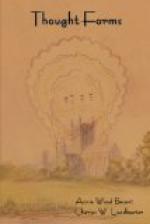These are caused by the activity of the lower mind, throwing itself out through the astral body—the activity of Kama-Manas in theosophical terminology, or the mind dominated by desire. Vibrations in the body of desire, or astral body, are in this case set up, and under these this body throws off a vibrating portion of itself, shaped, as in the previous case, by the nature of the vibrations, and this attracts to itself some of the appropriate elemental essence of the astral world. Such a thought-form has for its body this elemental essence, and for its animating soul the desire or passion which threw it forth; according to the amount of mental energy combined with this desire or passion will be the force of the thought-form. These, like those belonging to the mental plane, are called artificial elementals, and they are by far the most common, as few thoughts of ordinary men and women are untinged with desire, passion, or emotion.
THE TWO EFFECTS OF THOUGHT
Each definite thought produces a double effect—a radiating vibration and a floating form. The thought itself appears first to clairvoyant sight as a vibration in the mental body, and this may be either simple or complex. If the thought itself is absolutely simple, there is only the one rate of vibration, and only one type of mental matter will be strongly affected. The mental body is composed of matter of several degrees of density, which we commonly arrange in classes according to the sub-planes. Of each of these we have many sub-divisions, and if we typify these by drawing horizontal lines to indicate the different degrees of density, there is another arrangement which we might symbolise by drawing perpendicular lines at right angles to the others, to denote types which differ in quality as well as in density. There are thus many varieties of this mental matter, and it is found that each one of these has its own especial and appropriate rate of vibration, to which it seems most accustomed, so that it very readily responds to it, and tends to return to it as soon as possible when it has been forced away from it by some strong rush of thought or feeling. When a sudden wave of some emotion sweeps over a man, for example, his astral body is thrown into violent agitation, and its original colours are or the time almost obscured by the flush of carmine, of blue, or of scarlet which corresponds with the rate of vibration of that particular emotion. This change is only temporary; it passes off in a few seconds, and the astral body rapidly resumes its usual condition. Yet every such rush of feeling produces a permanent effect: it always adds a little of its hue to the normal colouring of the astral body, so that every time that the man yields himself to a certain emotion it becomes easier for him to yield himself to it again, because his astral body is getting into the habit of vibrating at that especial rate.




